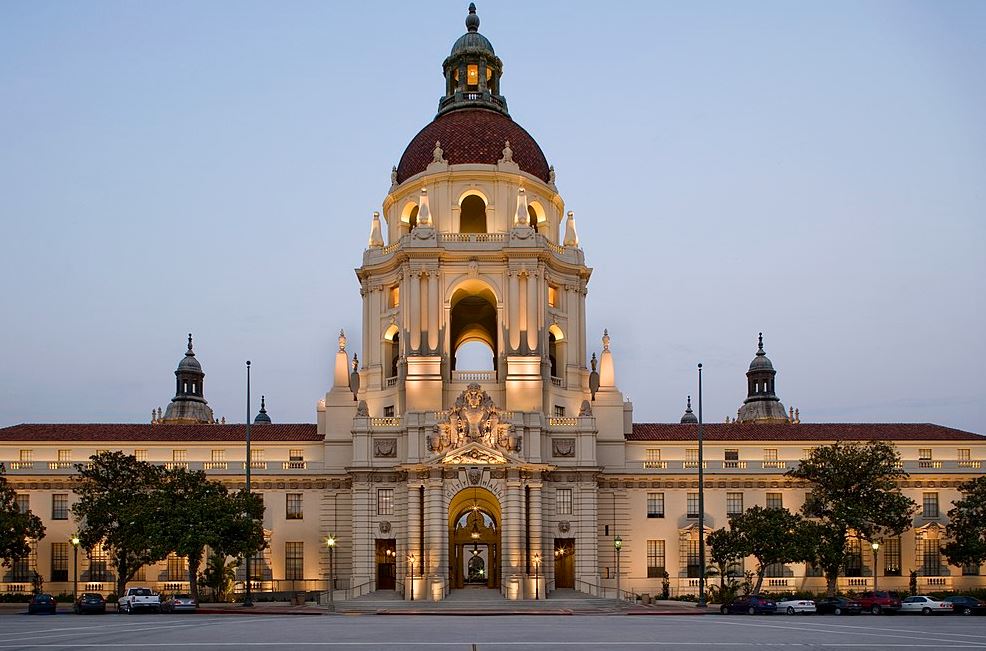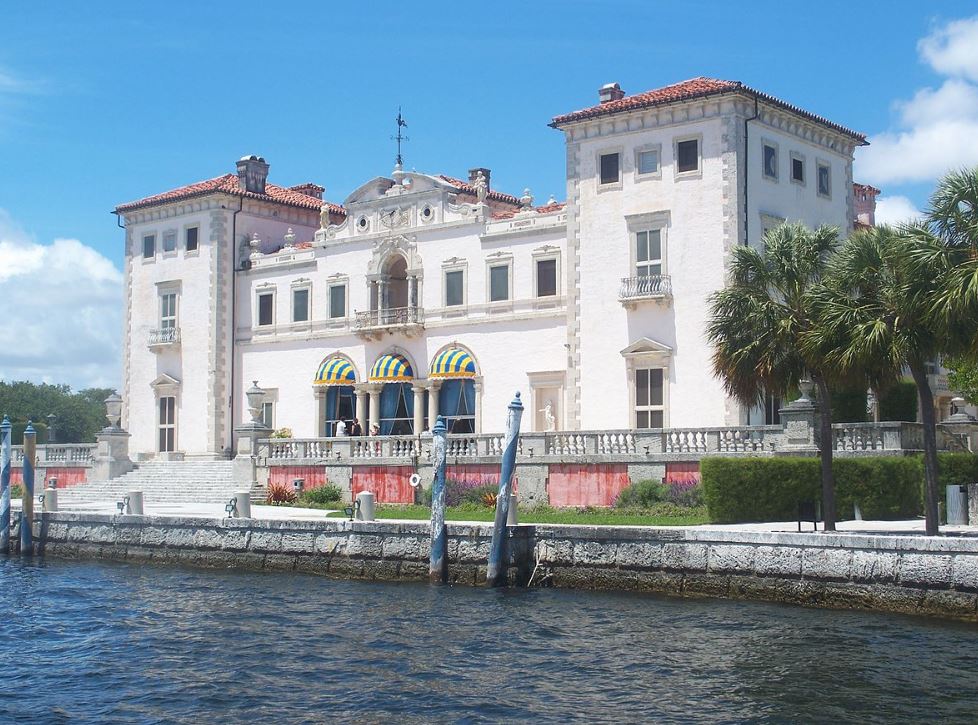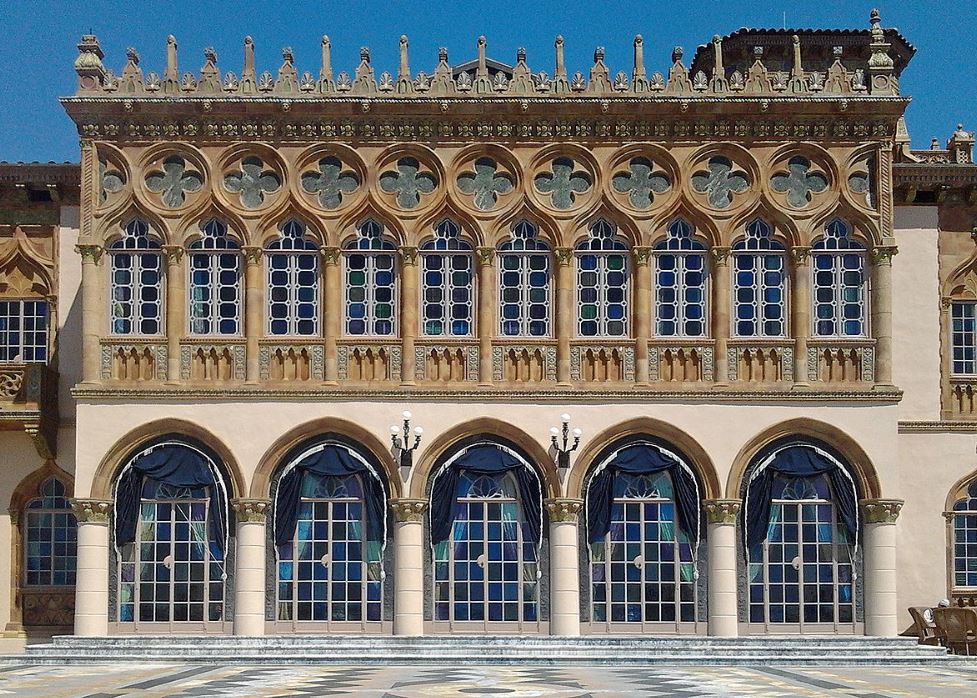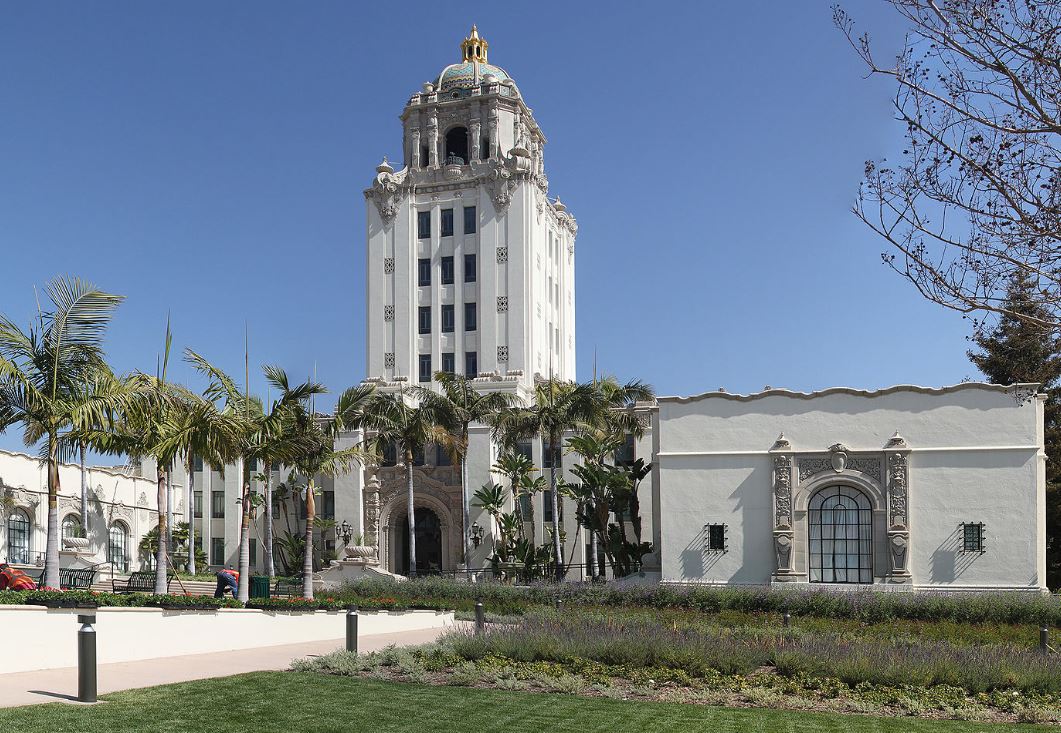When you visit Florida or California, you’re bound to discover several buildings that incorporate Mediterranean Revival architecture.
This eclectic style borrows elements from various other types of architecture, predominantly Spanish Colonial architecture, Renaissance architecture, Venetian Gothic architecture, and Beaux-Arts architecture.
With so many influences, it’s fairly clear that this isn’t a uniform style as it comes in many different variations.
Large façades, red-tiled roofs, arched or circled windows, and wood or wrought iron balconies are just some of the characteristics of Mediterranean Revival buildings.
The style first emerged in the 19th century, peaked during the 1920s and 1930s, and spread from Florida and California to other parts of the country and Canada.
Let’s take a closer look at some of the best examples of this type of architecture.
1. Breakers Hotel – Palm Beach, Florida
The Breakers Hotel in Palm Beach is a magnificent and opulent icon of Florida’s Gilded Age! This grand hotel, which opened its doors in 1896, is a stunning testament to the vision of its founder, oil tycoon Henry Flagler, who sought to create a luxurious retreat for the wealthy elite of America.
As you step inside the Breakers, you’ll be immediately struck by the sheer scale and grandeur of the architecture. The building itself is a masterpiece of Mediterranean Revival design, with an imposing facade featuring towering columns, elaborate carvings, and intricate moldings. The majestic entrance is framed by two bronze lion statues, which guard the hotel like sentinels, beckoning you to enter the realm of luxury and indulgence.
Once inside, you’ll be awed by the soaring ceilings, glittering chandeliers, and ornate frescoes that adorn the walls and ceilings. Every corner of the hotel is a work of art, from the sweeping staircases that lead to the upper floors, to the cozy nooks and crannies where guests can relax and unwind. The Breakers is a true feast for the senses, with lavish furnishings, fine art, and sumptuous fabrics that create an ambiance of refined elegance.
The hotel has hosted countless luminaries over the years, from presidents and royalty to Hollywood stars and business moguls. During World War II, the hotel was even used as a training facility for the US Army Air Forces, and some of the original barracks can still be seen on the grounds today.
So come and experience the grandeur and glamour of the Breakers Hotel in Palm Beach – a true gem of American architecture and history. Whether you’re sipping a cocktail by the pool, strolling along the private beach, or simply soaking up the ambiance of the magnificent lobby, you’ll feel like you’ve stepped into a bygone era of elegance and sophistication.

2. Pasadena City Hall – Pasadena, California
The Pasadena City Hall is a stunning masterpiece of Mediterranean Revival architecture that has been a fixture of Pasadena’s civic life since its construction in 1927. Designed by renowned architect Bertram Goodhue, the City Hall is a testament to the artistry and craftsmanship of a bygone era.
As you approach the City Hall, you’ll be struck by the grandeur of the building’s façade, with its soaring bell tower and ornate arches that evoke the elegance of the Spanish Renaissance. The exterior is clad in creamy white terra cotta tiles, which shimmer in the California sun and give the building a timeless quality.
Inside, the City Hall is no less impressive, with a sweeping marble staircase that leads to the upper floors and a central courtyard that is a tranquil oasis in the heart of the city. The lobby is adorned with murals by local artist and illustrator Dean Cornwell, which depict the history of California and the founding of Pasadena.
The City Hall’s ornate council chambers are equally impressive, with a soaring coffered ceiling, hand-carved wooden chairs, and stained-glass windows that filter the sunlight into a rainbow of colors. The chambers have played host to countless important events and meetings over the years, including the swearing-in of President Barack Obama in 2009.
Whether you’re admiring the beauty of the building’s façade, exploring the intricate details of its interior, or participating in a community event on the grounds, you’ll be immersed in the rich culture and history of Pasadena.

3. Villa Vizcaya – Miami, Florida
Villa Vizcaya is a magnificent Italian Renaissance-style villa that is a jewel of Miami’s cultural heritage. Constructed in the early 20th century by industrialist James Deering, the villa is a true masterpiece of art and architecture that has been delighting visitors for over a century.
As you approach the villa, you’ll be greeted by lush gardens and ornate fountains that lead to the majestic entrance, which is flanked by two bronze lion statues. The villa’s façade is a marvel of symmetry and balance, with arched windows, ornate columns, and intricate stonework that reflect the beauty of Italian Renaissance architecture.
Inside, the villa is no less impressive, with opulent furnishings, fine art, and exquisite craftsmanship that create an ambiance of refined elegance. The grand hall is a particular highlight, with its soaring ceilings, sparkling chandeliers, and stunning frescoes that depict scenes from classical mythology.
The villa’s many rooms and galleries are filled with treasures from around the world, including rare books, antique furniture, and exquisite art collections. One of the most impressive rooms is the Music Room, which is adorned with elaborate carvings and features a magnificent organ that still works today.
But perhaps the most stunning feature of Villa Vizcaya is its lush gardens, which were designed to reflect the beauty and tranquility of Italian Renaissance gardens.
The gardens are filled with fountains, sculptures, and manicured lawns, as well as rare and exotic plants from around the world. The gardens have been a favorite spot for visitors and locals alike for over a century, and are a true oasis of beauty and serenity in the heart of Miami.

4. Snell Arcade – St. Petersburg, Florida
The Snell Arcade is a beloved St. Petersburg landmark that has been a hub of social and commercial activity since its construction in 1925. Designed by architect George Feltham, the Snell Arcade is a stunning example of Mediterranean architecture that continues to captivate visitors with its beauty and charm.
The building features arched entranceways, ornate balconies, and a red-tile roof that harkens back to the golden age of Florida’s architectural style. The Arcade’s façade is a striking combination of Spanish Colonial and Italian Renaissance influences, with intricate stucco work and elegant terra cotta ornamentation that reflect the building’s historical significance.
Inside, the Snell Arcade is a treasure trove of unique shops, boutiques, and galleries, as well as a few small offices. The Arcade’s central atrium is a bustling hub of activity, with a stunning glass ceiling that floods the space with natural light. The atrium’s original black and white checkerboard floors, marble columns, and ornate wrought-iron railings create a sophisticated and timeless atmosphere that is a true delight to the senses.
The Snell Arcade has been an important center of commerce and culture for almost a century, with a rich history that is woven into the fabric of St. Petersburg itself. The Arcade has played host to countless events and celebrations over the years, from fashion shows and art exhibitions to live music and charity fundraisers. It has been a beloved gathering place for locals and visitors alike, and a testament to the enduring spirit and charm of this vibrant coastal city.
Whether you’re strolling through the atrium, browsing the eclectic array of shops and galleries, or simply taking in the building’s architectural splendor, you’ll be transported to a world of elegance and sophistication that is uniquely Floridian.

5. Ca’ d’Zan – Sarasota, Florida
The Ca’ d’Zan is a spectacular mansion that sits on the shores of Sarasota Bay. Constructed in the 1920s by circus magnate John Ringling and his wife Mable, the mansion is a stunning example of opulent Florida architecture that has been captivating visitors for nearly a century.
The building features ornate arches, terra cotta tiles, and towering chimneys that evoke the romance and glamour of the Italian Renaissance. The mansion’s façade is a masterpiece of design, with intricately carved stone columns, delicate ironwork, and a stunning dome that crowns the building’s central courtyard.
Inside, Ca’ d’Zan is no less impressive, with lavishly decorated rooms that are filled with exquisite furnishings, rare art collections, and stunning architectural details. The mansion’s grand ballroom is particularly breathtaking, with its soaring ceilings, glittering chandeliers, and sweeping views of the bay.
The gardens are filled with fountains, sculptures, and manicured lawns, as well as rare and exotic plants from around the world. The mansion’s outdoor terrace, with its sweeping views of Sarasota Bay, is a favorite spot for visitors and locals alike.

6. Catalina Casino – Avalon, California
The Catalina Casino is a majestic Mediterranean Revival and Art Deco landmark located on the beautiful island of Santa Catalina off the coast of California. It was constructed in 1929 by William Wrigley Jr., the famous chewing gum magnate, the Casino is a true masterpiece of design that has been captivating visitors for almost a century.
The building features a stunning façade, elegant lines, sweeping curves, and intricate details that are characteristic of the Art Deco style. The building’s bright white walls and colorful accents give it a unique sense of energy and vitality that is perfectly suited to its island setting.
Inside, the Catalina Casino features a grand ballroom that is the largest circular ballroom in the world. The ballroom is a masterpiece of Art Deco design, with a soaring ceiling, glittering chandeliers, and a stunning sunburst pattern on the dance floor that radiates out from a central stage.
The Casino also features a state-of-the-art movie theater that has been screening films since the 1930s, as well as a museum that showcases the island’s rich history and cultural heritage.
But perhaps the most enchanting feature of the Catalina Casino is its breathtaking views of the Pacific Ocean and the surrounding island landscape. The Casino’s outdoor terrace is a popular spot for visitors to enjoy a sunset cocktail or a romantic stroll under the stars, with panoramic views that are truly awe-inspiring.

7. Beverly Hills City Hall – Beverly Hills, California
Beverly Hills City Hall is a magnificent building in California that has been serving the community since 1932. This stunning architectural masterpiece is a true testament to the glamour and elegance of Beverly Hills, with its grand façade and intricate details that showcase the city’s unique blend of sophistication and style.
The building features towering walls, sweeping curves, and a striking tower that commands attention from miles around. The building’s bright white walls and colorful accents give it a sense of energy and vitality that is perfectly suited to the city’s vibrant character.
Inside, Beverly Hills City Hall is equally impressive with a grand entrance hall. The hall is adorned with intricate carvings, colorful murals, and stunning chandeliers that evoke the glamour and elegance of Hollywood’s Golden Age. The building’s grand council chamber is another highlight, with its soaring ceiling, sparkling lighting, and ornate decorations that make it one of the most beautiful rooms in the city.
The most enchanting feature of Beverly Hills City Hall is its beautiful rooftop garden which offers stunning views of the surrounding hills and canyons. The garden is a favorite spot for locals and visitors alike, with its manicured lawns, colorful flowers, and charming fountains that provide a peaceful oasis in the heart of the city.

8. Wolfsonian-FIU – Miami Beach, Florida
The Wolfsonian-FIU is a unique museum located in the heart of Miami Beach. Housed in a stunning Mediterranean Revival building, the museum is dedicated to exploring the art, design, and material culture of the modern age, with a particular focus on the period from 1885 to 1945.
The building features a distinctive façade that has bold geometric shapes, sleek lines, and striking colors that are characteristic of this type of architecture. Its bright white walls and colorful accents give it a sense of energy and vitality that is perfectly suited to the dynamic cultural scene of Miami Beach.
The museum houses a vast collection of over 180,000 objects that span a wide range of media, including furniture, ceramics, glass, metalwork, textiles, and more. The museum’s galleries are arranged thematically, with exhibitions that explore topics such as advertising, propaganda, technology, and industrial design.
One of the highlights of the Wolfsonian-FIU is its impressive library, which houses over 70,000 books, periodicals, and ephemera that offer a rich and diverse perspective on the modern age. The library’s reading room is a favorite spot for scholars and researchers, with its comfortable chairs, expansive windows, and stunning views of Miami Beach.



